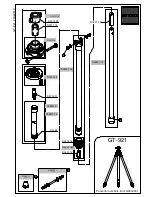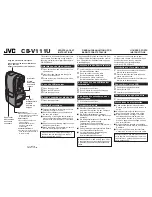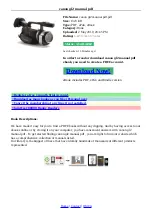
113
VQT2L14
When the status indicator is flashing at a
particularly fast or slow rate, the
following should be considered.
Flashing with approx. 4 second period
(off for approx. 2 seconds, on for approx.
2 seconds):
≥
The battery may be over-discharged, or
the battery temperature may be high or
low. The battery will charge, but it may
take several hours for normal charging to
begin.
Flashing with approx. 0.5 second period
(off for approx. 0.25 second, on for
approx. 0.25 second):
≥
The battery is not charged. Remove the
battery from the unit, and try charging
again.
≥
Check that the terminals of the unit or
battery are not dirty or covered in a foreign
object, and connect the battery correctly
once again. If a foreign object or dirt is
present, turn off the unit before removing.
≥
The battery or environment is at an
extremely high or low temperature. Wait
until the temperature has returned to an
appropriate level and try charging again. If
you are still unable to charge, there may
be a fault in the unit, battery or AC
adaptor.
Lamp turns off:
≥
Charging has finished.
≥
If the status indicator stays off despite the
charging being unfinished, there may be a
fault in the unit, battery or AC adaptor.
Contact consumer support. (
l
124, 125)
≥
Refer to page 111 for details on the
battery.
≥
The memory capacity indicated on the
label of an SD card is the total of the
capacity for copyright protection and
management and the capacity which can
be used on the unit, a PC etc.
≥
Do not apply strong shocks, bend, or drop
the SD card.
≥
Electrical noise, static electricity or the
failure of this unit or the SD card may
damage or erase the data stored on the
SD card.
≥
During long periods of use, it is normal for
this unit and the SD card to become
slightly warm and is not a malfunction.
When the card access lamp is lit, do not:
j
Remove the SD card
j
Turn the unit off
j
Insert and remove the USB cable
j
Expose the unit to vibrations or shock
Cautionary points when handling
≥
Do not expose the terminals of the SD
card to water, garbage or dust.
≥
Do not place SD cards in the following
areas:
j
Areas exposed to direct sunlight, or in
high-temperature areas such near
heating equipment.
j
In very dusty or humid areas.
j
Locations susceptible to significant
difference in temperature (condensation
can occur).
j
Where static electricity or
electromagnetic waves occur.
≥
To protect SD cards, return them to their
cases when you are not using them.
When disposing of or giving away an SD
card, note that:
≥
Formatting and deletion simply change the
file management information and cannot
be used to completely erase the data in an
SD card.
≥
We recommend that you physically format
an SD card before disposing of or giving
away the SD card.
About charging errors
About SD cards
SDR-H85&S50&T55&T50-VQT2L14_eng.book 113 ページ 2009年12月22日 火曜日 午前10時33分
Содержание SDR-H85A
Страница 131: ...131 VQT2L14 ...
















































